-
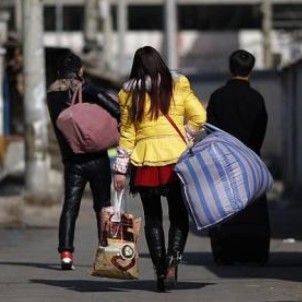
【海峡时报】Beijing to study migration issues by joining IOM: Official
CHINA is seeking to become a full member of the International Organisation for Migration (IOM), which shows its seriousness in wanting to better manage the transition of rural workers to the cities and to attract global talent for its economic restructuring drive.Its intention was revealed at the International Forum on Global Migration and Development in Beijing yesterday by Professor Wang Huiyao, president of independent think-tank Centre for China and Globalisation (CCG).He said China, an IOM observer-state since 2001, hopes to become a member so as "to pick up useful and interesting lessons" on migration issues.IOM chief of staff Ovais Sarmad, who was at the forum organised jointly by the CCG and the China Global Talents Society, confirmed China’s interest. "In my discussions with the Chinese government officials, I was told they are seriously looking at a formal membership," he told The Straits Times.Founded in 1951, the IOM is an inter-government organisation with 157 member-states, and is also the world’s leading outfit helping to improve migration-related policies and also respond to emergencies such as refugee crises. It has offices in more than 100 countries, including in Beijing.Yesterday’s event was billed as China’s first high-level forum on global migration, and is seen as a firm signal from the Chinese leadership of its renewed resolve to step up efforts and research on this issue. Issues discussed by the more than 100 participants from over 10 countries centred on how governments can cope with challenges and opportunities arising from global migration trends.For instance, Dr Sarmad pointed out, some one billion people or one-sixth of the global population are in some form of migration, with 240 million crossing international borders and the rest moving within their countries. "We call this the era of unprecedented Asian mobility. There is huge potential that needs to be managed and governed," he said.China’s millions of rural workers, who have flocked from villages to cities over the past three decades and are expected to continue doing so over the coming years, are a good example of domestic migrants, he added.Rural workers pose one of the key migration challenges for China’s government as they are counted on to help boost domestic consumption, identified as a future driver of China’s economic growth. But to do so, China has to expand their access to public services in cities while assuaging the concerns of urban residents over the inflows of migrants.Another challenge lies in retaining talented locals and attracting skilled foreigners who may be deterred by the slowing economy and an increasingly polluted living environment. Professor Liu Xuezhi, vice-president of the Chinese Academy of Personnel Sciences, said China could enhance its appeal to talented individuals if they are given opportunities to be involved in restructuring the economy and improving one of the world’s most polluted countries.Dr Howard Duncan, executive head of the Metropolis Project, a network of experts from over 70 countries on migration and cities, urged China to also open its arms wider to young foreigners who could help in its drive to become a more innovative economy. He also noted how overseas Chinese and skilled foreign talent had been enticed to come here by the emotional appeal that they would be seeing a history-making period of rapid economic growth."Now it should think likewise about the emotional aspect in luring foreign talent to China," he said.(By Kor Kian Beng)
2015年4月24日 -
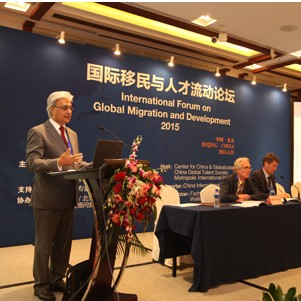
【环球时报】新媒:北京决意加大移民研究 欲加入国际移民组织
新加坡《海峡时报》4月22日文章,原题:官员们称,北京为研究移民问题而加入国际移民组织 中国正寻求成为国际移民组织的正式成员。这表明中国确实想要更好地管理农民工进城并吸引全球人才参与其经济结构调整。 昨天在北京举行的国际移民与人才流动论坛上,这种意图由独立智库中国与全球化中心主任王辉耀教授披露。他说,中国希望在移民问题上“吸取有用和有意思的经验教训”。国际移民组织办公室主任奥瓦伊斯·萨马德对此予以证实,“我与中国官员讨论时,获知他们正认真考虑成为正式成员国。” 国际移民组织是全球帮助改进移民政策和应对难民危机等紧急事务的主要机构,在100多个国家(包括在北京)设有办事处。中国于2001年成为观察员国。 昨天的论坛是中国首次举办的有关全球移民的高级论坛,被视为一个明确信号——北京已决意在这方面加大研究和努力。 萨马德说,过去30年来成千上万农民工涌入城市,今后这种趋势仍将继续。这是中国面临的一个移民挑战,政府希望他们能帮助提振国内消费。为此,必须扩大农民工在城市获得公共服务的机会,同时要缓解城市居民对移民涌入的担忧。 另一个挑战在于留住本地人才并吸引有技能的外国人。经济减速和日益污染的生活环境可能让外国人对中国望而却步。国际大都市组织执行总干事霍华德·邓肯博士呼吁中国对外国年轻人敞开更大的怀抱,他们有助于中国发展更具创新的经济体。
2015年4月24日 -
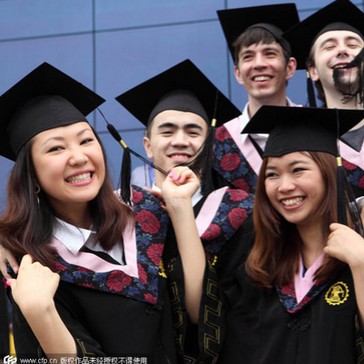
【中国日报】Think-tank says actions needed to reduce ’talent deficit’
China is urged to improve conditions to attract more talented foreigners and reduce its "talent deficit", according to a migration report released Thursday by a Chinese think-tank.According to the Annual Report on Chinese International Migration issued by the Center for China and Globalization(CCG), there were 848,500 foreigners in China in 2013, accounting for 0.06 percent of the total population and there are currently about 60 million overseas Chinese living in 198 counties and regions.The percentage of foreigners in the population of many Western countries exceeded 10 percent, the report found.About 6000 foreigners were granted permanent residence in China between 1985 and 2012. In contrast, more than 100,000 Chinese received permanent residence in other countries annually in recent years.Some 356,000 foreign students studied in 746 educational institutions in China in 2013, but were unable to receive work visas upon graduation, the report noted.The number of Chinese students going abroad for study reached 414,000 in 2013 and 354,000 students returned home after studying abroad in the same year.The report found foreign students are among the major sources of overseas talent in developed countries and it is common practice to issue work visas to students in these regions.The report also highlighted language and cultural barriers as obstacles for foreign talent in China.The migration report also found an increasing number of Chinese immigrating into other countries through investment. There were 13,000 Immigrant Investors from China in 2012, 12,000 in 2011 and 8000 in 2010.In 2013, 6,895 Chinese were granted the US EB-5 visas, which are specially issued to Immigrant Investors, 9 times of the number in 2010.The report put forward suggestions for making the most use of international migrants and talents, along with ways of better enforcing and developing China’s international migrant system.It reviewed the new immigration policies and laws implemented by other countries to attract foreign entrepreneurs and investors, suggesting that China administrate foreigners according to the law, improve the visa system and establish a special residence permit mechanism.The State Council announced last month that China will push forward legislation on issuing permanent residence to foreigners, lift the threshold for technical talent to apply for permanent residence and build a mechanism on skilled migration.According to the plan, foreigners who meet China’s criteria can enjoy preferential policies in applying for work permits, and their accompanying family members will also be given visas and residence permits.
2015年4月24日 -
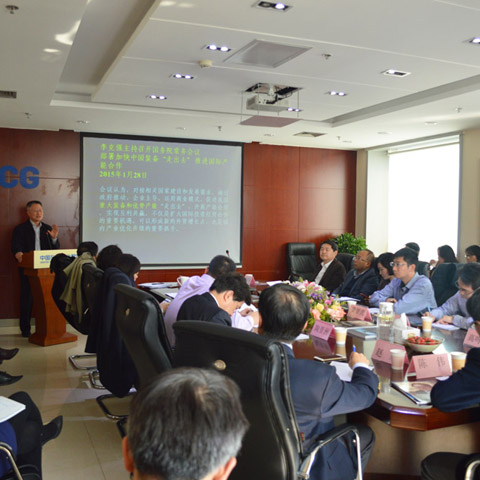
【北京晨报】亚投行短缺小语种人才
北京晨报讯 近日,由中国与全球化智库(CCG)、欧美同学会2005委员会主办的“CCG智库圆桌会”在京举行。针对一带一路战略、亚投行所面临的人才短缺问题以及解决方案,来自政府、企业和智库的专家进行了探讨。 CCG主任、国务院参事王辉耀指出,一带一路战略实施中有着很大的人才缺口,其中包括小语种。中国工商银行副行长、CCG副主席张红力对此表示认同:“公司要招聘小语种人才确实存在困难,俄罗斯语、阿拉伯语、西班牙语、泰语等都需要从学校开始加强培养。” 中组部人才局原副巡视员胡建华强调了国际化人才需要具备的素质:“第一要有国际一流的知识结构,二是要精通几门外语,三是要了解别国的国际惯例、法律法规、风土人情,还要有一种文化的包容的思维和意识。”
2015年4月24日 -
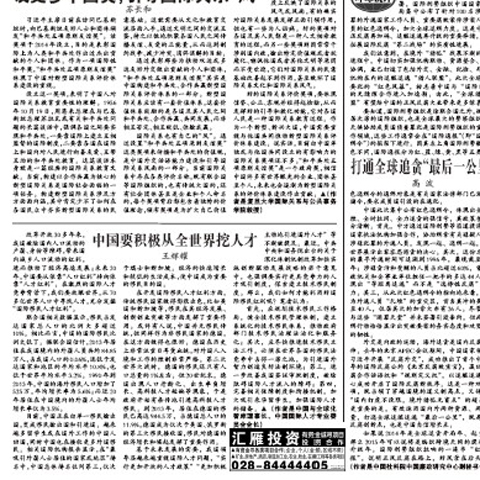
王辉耀:中国要积极从全世界挖人才
改革开放30多年来,我国破除国内人口流动的户籍、身份等障碍,带来国内城乡人口流动的红利,进而推动了经济高速发展;未来30年,中国要从依靠“人口红利”转向依靠“人才红利”。在激烈的国际人才竞争背景下,我们要放眼世界,从70多亿世界人口中寻找人才,充分发掘“国际移民人才红利”。 联合国相关数据显示,移民占发达国家总人口的比例大多超过10%。相比而言,中国的国际移民比例太低了。据联合国估计,2013年居住在我国境内的外籍人员共约84.85万人,占我国人口的0.06%,远低于发达国家和地区的平均水平10.8%,也低于世界平均水平3.2%。1990年到2013年,中国的海外移民人口增加了525万,年均增长率为5.6%;而近20年居住在中国境内的外籍人士年均增长率仅为3.5%。 目前,中国正在由单一移民输出国,变成移民输出国和引进国。越来越多留学生或在国外工作的中国人回国,同时中国也在接收更多外国移民。相关国际机构报告显示,在“最吸引外籍人士居住的国家或地区”排名中,中国总体排名位列第三,仅次于瑞士和新加坡。经济的快速增长和较低的生活成本,使中国成为重要的移民目的国。 在开发国际移民人才红利方面,传统移民国家做得都很出色,比如美国和新加坡等,移民在其经济发展、创新创业突破等方面发挥了重要作用。或许有人说,中国并无移民传统,但同样作为非移民国家的德国,在这方面做得也很好。德国在历史上非常注重日耳曼血统,对外国人入境和工作的控制非常严格。第二次世界大战时,德国的移民还只有人口总量的1%左右。但20世纪末,德国出现人口老龄化、出生率负增长、高科技人才短缺等现象,于是政府开始有条件地引进高科技人才移民。到2013年,居住在德国的移民已高达984.5万,占德国总人口的11.9%,德国成为仅次于美国、俄罗斯的第三大移民接收国,移民对德国的经济增长和崛起发挥了重要作用。 基于未来发展的需要,我国领导层越来越重视国际人才问题,“实行更加开放的人才政策”“更加积极主动地引进国外人才”等不断被提及。最近,中共中央和国务院出台的关于深化体制机制改革加快实施创新驱动发展战略的若干意见中,也强调要实行更具竞争力的人才吸引制度,探索建立技术移民制度。那么,我们如何才能利用好国际移民红利呢?笔者认为: 首先,应规划技术移民工作格局,健全技术移民管理体制,建立系统化的技术移民体系,推动政府部门技术移民治理法治化和服务化;其次,应尽快推进技术移民立法工作,必须在世界各国的移民法竞争中占得一席之地,为引进国外智力创造良好法制环境;第三,进一步改善我国签证审批制度,破除阻碍国际人才流入的障碍;第四,完善相关保障制度和衔接机制,加大吸引来华留学生,加强国际人才的储备。
2015年4月24日 -
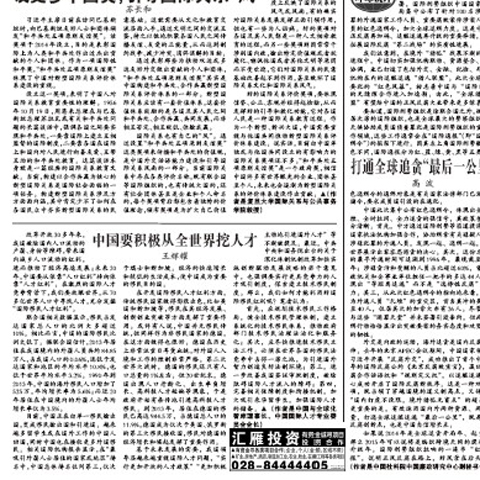
【环球时报】中国要积极从全世界挖人才
改革开放30多年来,我国破除国内人口流动的户籍、身份等障碍,带来国内城乡人口流动的红利,进而推动了经济高速发展;未来30年,中国要从依靠“人口红利”转向依靠“人才红利”。在激烈的国际人才竞争背景下,我们要放眼世界,从70多亿世界人口中寻找人才,充分发掘“国际移民人才红利”。 联合国相关数据显示,移民占发达国家总人口的比例大多超过10%。相比而言,中国的国际移民比例太低了。据联合国估计,2013年居住在我国境内的外籍人员共约84.85万人,占我国人口的0.06%,远低于发达国家和地区的平均水平10.8%,也低于世界平均水平3.2%。1990年到2013年,中国的海外移民人口增加了525万,年均增长率为5.6%;而近20年居住在中国境内的外籍人士年均增长率仅为3.5%。 目前,中国正在由单一移民输出国,变成移民输出国和引进国。越来越多留学生或在国外工作的中国人回国,同时中国也在接收更多外国移民。相关国际机构报告显示,在“最吸引外籍人士居住的国家或地区”排名中,中国总体排名位列第三,仅次于瑞士和新加坡。经济的快速增长和较低的生活成本,使中国成为重要的移民目的国。 在开发国际移民人才红利方面,传统移民国家做得都很出色,比如美国和新加坡等,移民在其经济发展、创新创业突破等方面发挥了重要作用。或许有人说,中国并无移民传统,但同样作为非移民国家的德国,在这方面做得也很好。德国在历史上非常注重日耳曼血统,对外国人入境和工作的控制非常严格。第二次世界大战时,德国的移民还只有人口总量的1%左右。但20世纪末,德国出现人口老龄化、出生率负增长、高科技人才短缺等现象,于是政府开始有条件地引进高科技人才移民。到2013年,居住在德国的移民已高达984.5万,占德国总人口的11.9%,德国成为仅次于美国、俄罗斯的第三大移民接收国,移民对德国的经济增长和崛起发挥了重要作用。 基于未来发展的需要,我国领导层越来越重视国际人才问题,“实行更加开放的人才政策”“更加积极主动地引进国外人才”等不断被提及。最近,中共中央和国务院出台的关于深化体制机制改革加快实施创新驱动发展战略的若干意见中,也强调要实行更具竞争力的人才吸引制度,探索建立技术移民制度。那么,我们如何才能利用好国际移民红利呢?笔者认为: 首先,应规划技术移民工作格局,健全技术移民管理体制,建立系统化的技术移民体系,推动政府部门技术移民治理法治化和服务化;其次,应尽快推进技术移民立法工作,必须在世界各国的移民法竞争中占得一席之地,为引进国外智力创造良好法制环境;第三,进一步改善我国签证审批制度,破除阻碍国际人才流入的障碍;第四,完善相关保障制度和衔接机制,加大吸引来华留学生,加强国际人才的储备。
2015年4月24日 -
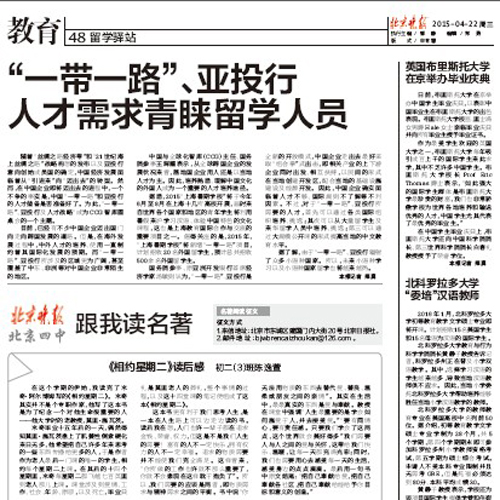
【北京晚报】“一带一路”、亚投行 人才需求青睐留学人员
随着“丝绸之路经济带”和“21世纪海上丝绸之路”战略构想的发布以及亚投行意向创始成员国的确定,中国经济发展面临着从“引进来”向“迈出去”的转型。然而,在中国企业即将迈出去的进程中,一个不争的事实是,中国“一带一路”和亚投行的人才储备是否准备好了。为此,“一带一路”、亚投行及人才战略“成为CCG智库圆桌会的一个主题。 目前,已经有不少中国企业迈出国门向走向跨国发展的道路。但是,在海外发展过程中,中外人才的培养、使用一直制约着其国际化发展的预期。而“一带一路”、亚投行所涉及的区域更为广阔,甚至覆盖了中东、非洲等对中国企业非常陌生的地区。 中国与全球化智库(CCG)主任、国务院参事王辉耀表示,从全球跨国企业的发展状况来看,落地国企业用人还是以当地人才为主。因此,培养熟悉、理解中国文化的外国人成为一个重要的人才培养途径。 据悉,2015“上海暑期学校”将于今年6月至8月在上海十几所高校开展,届时来自世界各个国家和地区的青年学生将利用暑假来沪学习汉语、体验中国特色的文化课程,这也是上海教育国际合作与交流的重要项目之一。值得关注的是,2015年,“上海暑期学校”将新增“一带一路”项目,计划招收20名外国留学生,预计总共招收500余名外国留学生。 国务院参事、原亚洲开发银行首席经济学家汤敏则认为,“一带一路”、亚投行是全新的开放模式,中国企业走出去最好采取“组合拳”式出击,即相关产业的上下游企业同时出发、相互扶持,以民间的形式在当地创建开发区,配合当地的基础设施建设及能源开发。因此,中国企业确实面临着人才不够、国际规则不了解等不利因素。不过,对于“一带一路”、亚投行所需要的人才,首先可以通过各类国际组织培养、挑选;其次可以从大量留学生及来华留学人员中培养、挑选;第三可以通过大规模公开课的形式提高当地的中文教育水平。 据了解,由于“一带一路”、亚投行辐射了众多小语种国家。所以,未来小语种学习以及小语种国家留学也将越来越热。
2015年4月23日